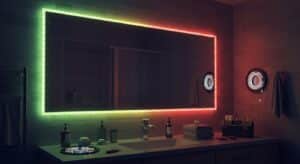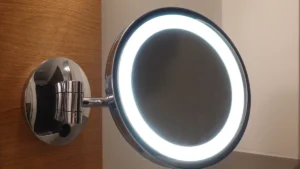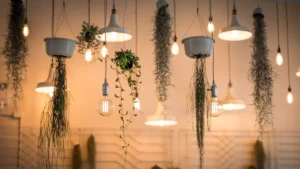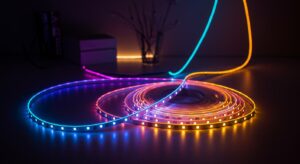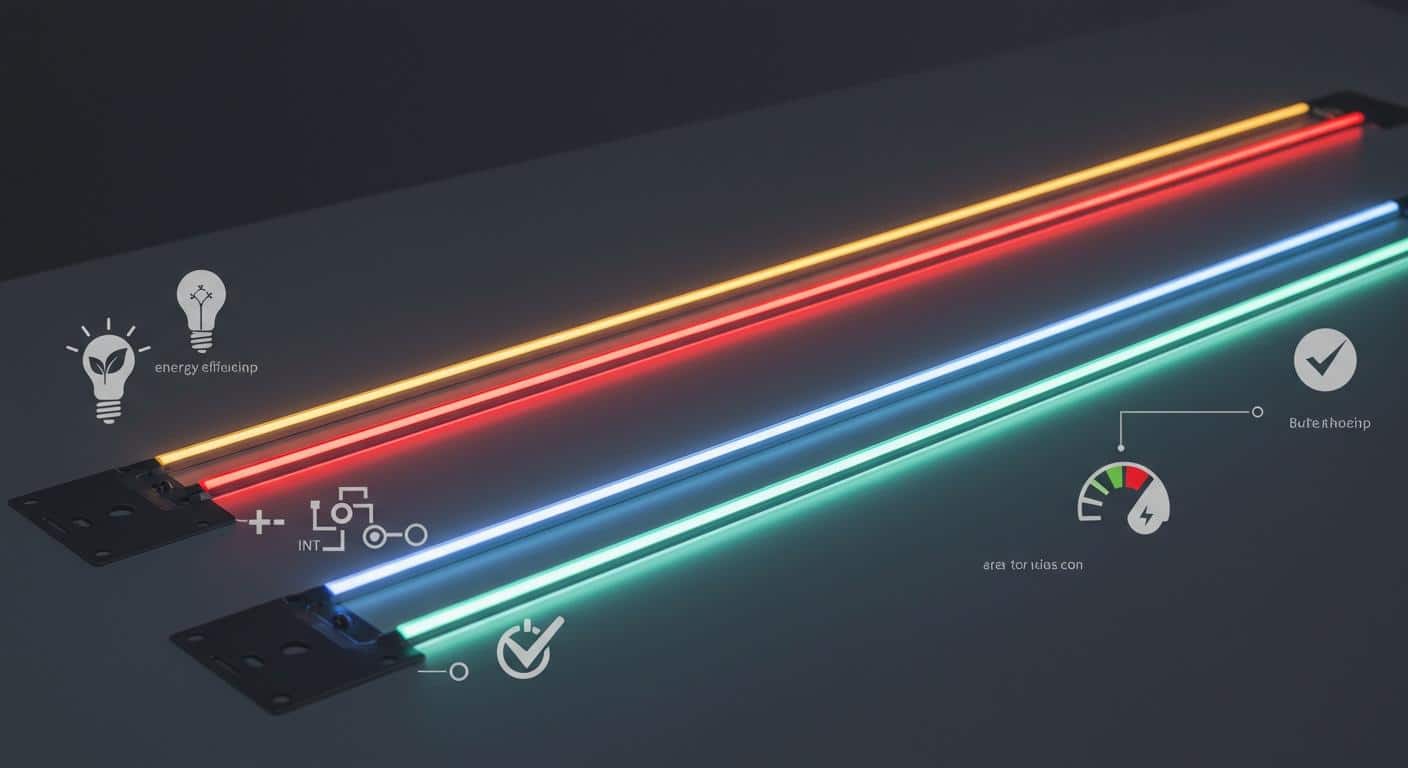
Energy efficiency is very important for lighting today. Did you know lighting uses about 20-30% of a building’s energy? That’s a big amount! By using linear lighting LED strips, you can lower your energy bills. They also last longer—over 50,000 hours compared to only 1,000 hours for regular bulbs. This change can save you up to 80% on energy! When picking the best linear lighting LED strips, think about brightness, color temperature, and how to install them. This will help you find what works best for you.
Key Takeaways
Pick LED strips that save energy. They can cut your energy bills by up to 80% compared to regular bulbs.
Pay attention to lumens, not watts, for brightness. More lumens mean brighter light, which is important for different rooms.
Think about color temperature for the right mood. Warm light feels cozy for relaxing areas, while cool light works best for workspaces.
Check for Energy Star certification. This shows your LED strips follow strict energy-saving rules, saving you money and helping the planet.
Plan your setup carefully. Choose between doing it yourself or getting professional help based on how comfortable you feel and how hard the project is.
Brightness and Lumens
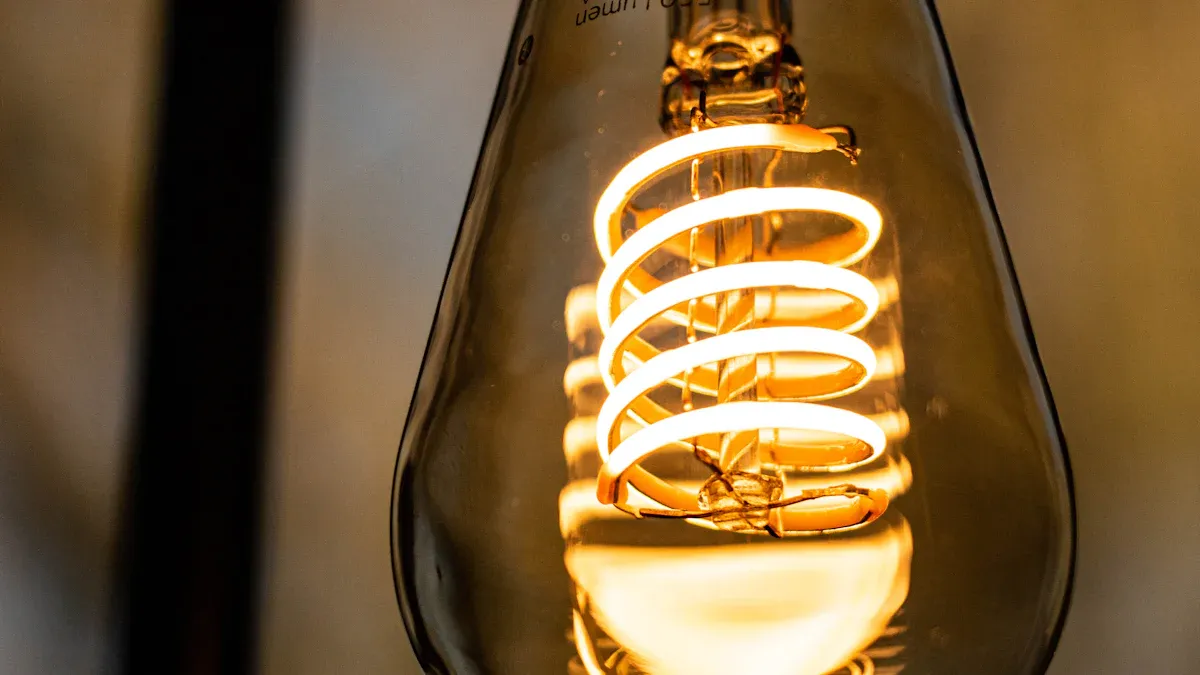
What are Lumens?
Lumens measure how much light a light source gives off. When you look for brightness in linear lighting LED strips, focus on lumens, not watts. Why? Watts show how much energy a light uses. But lumens show how much light you actually get.
Here’s a quick breakdown of lumens:
Lumens measure the total visible light from an LED source.
More lumens mean brighter light, which is important for choosing the right lighting.
The number of LEDs in a strip affects brightness and evenness.
To help you understand better, here’s a table comparing lumen output for different lights:
Lighting Type | Power (W) | Lumen Output |
|---|---|---|
Incandescent Bulb | 60 | 800 – 1000 |
LED Strips | 60 | ~5000 |
As you can see, linear LED strips give off much more light while using the same power as regular bulbs. This is one reason many people are switching to LED lights.
Measuring Brightness Needs
When measuring brightness needs, think about what each room is used for. Different rooms need different brightness levels. For example, kitchens need bright light for cooking. Bedrooms can have softer, cozier light. Here’s a helpful table showing the recommended lumen output for different rooms:
Room | Foot-candles Needed |
|---|---|
Living Room | 10-20 |
Kitchen | 30-40 (General) |
Kitchen | 70-80 (Stove) |
Kitchen | 70-80 (Sink) |
Dining Room | 30-40 |
Bedroom | 10-20 |
Hallway | 5-10 |
Bathroom | 70-80 |
To find out how many lumens you need, follow these steps:
Decide how you will use the space.
Check the IES foot candle guide for suggestions.
Multiply the foot candle number by the size of your space.
For example, if your living room is 20 square meters, you’d want about 2000 to 3000 lumens for good brightness.
Remember, how bright you feel can also depend on things like color temperature and where you place your LED strips. For instance, putting LED strips close together can make the light more even, improving the room’s feel.
By knowing about lumens and how to measure your brightness needs, you can make smart choices when picking your linear lighting LED strips.
Color Temperature in LED Lighting Solutions
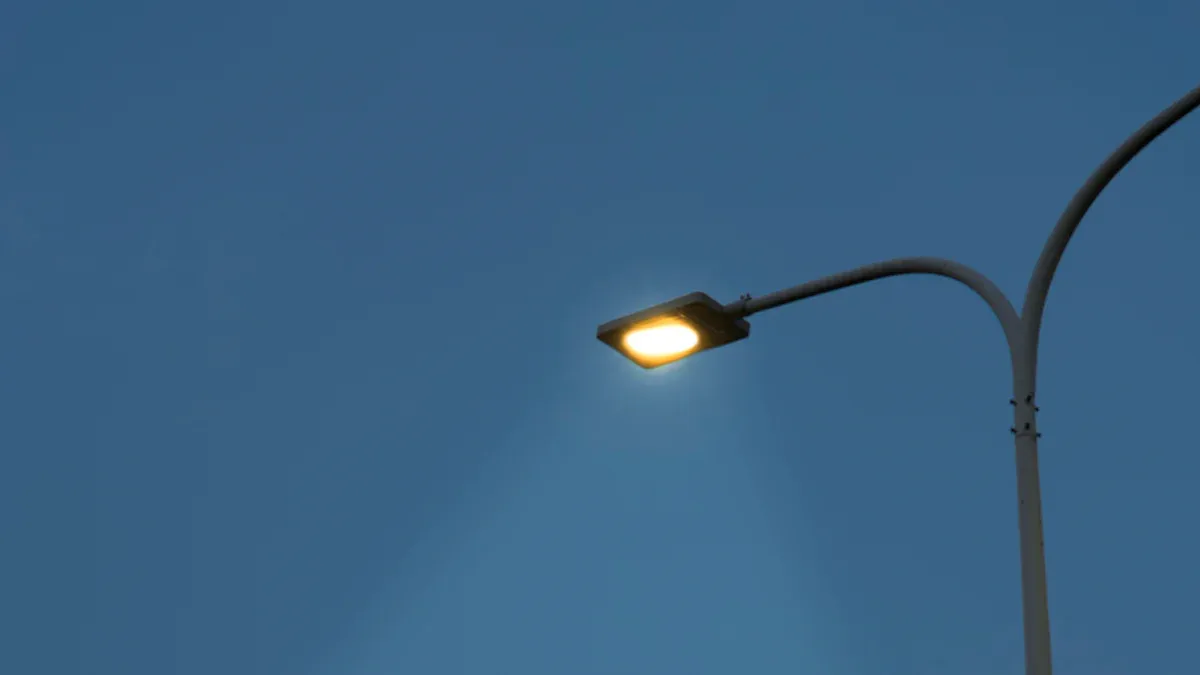
Warm vs. Cool Light
Color temperature shows how light looks. It is measured in Kelvin (K). It goes from warm light, around 2700K to 3000K, to cool light, which is between 4000K and 6500K. Warm light has a cozy, yellow color. It is great for relaxing spaces like living rooms and bedrooms. Cool light has a bright, blue-white color. This type is best for work areas like kitchens and home offices.
Here’s a quick look at where to use different color temperatures:
Color Temperature | Typical Applications | Description |
|---|---|---|
2700K-3000K | Living rooms, bedrooms, dining areas | Creates a calming and cozy feel, perfect for relaxing and socializing. |
4000K-6500K | Kitchens, bathrooms, home offices, retail stores | Offers bright, clear light for tasks, helping you focus and see better. |
Impact on Ambiance
The color temperature of your lights can change the mood of a room. For example, warm light helps you relax and feel comfortable. This makes it good for unwinding after a busy day. In contrast, cool light helps you stay alert and productive. That’s why you often find it in workspaces.
Check out this table that shows how different color temperatures affect feelings:
Color Temperature (K) | Description | Emotional Impact |
|---|---|---|
2000-3000 | Warm, yellow hue | Helps you relax and feel comfortable |
5000-6500 | Cool, blue-white light | Boosts productivity and alertness |
Bright, intense light | Invigorating and uplifting | Can cause discomfort if too bright |
Softer, dimmer light | Calming effect | Can make you feel sleepy if too dim |
When you pick your linear lighting LED strips, think about how the color temperature will change your space. You want to create a place that feels right for what you need. Whether you want a cozy corner or a bright work area, knowing about color temperature helps you choose the best option for you.
Energy Efficiency Ratings
Energy Star Certification
When you pick linear lighting LED strips, check for the Energy Star label. This label means the product follows strict energy rules from the U.S. Environmental Protection Agency. Energy Star products use about 90% less energy than regular incandescent bulbs. This helps you have bright lights while saving money on energy bills.
Here are some important points for Energy Star certification:
Criteria | Description |
|---|---|
Energy Efficiency | Uses 90% less energy than traditional incandescent bulbs. |
Light Distribution | Spreads light well with a special design for best results. |
Performance Testing | Tested for long-lasting use with at least a three-year warranty. |
By choosing Energy Star certified LED strips, you save money and help the planet. These products last longer and work better, making them a smart choice for your lighting needs.
Comparing Wattage and Output
Wattage can be confusing when talking about LED lights. You might think higher wattage means brighter light, but that’s not always true. With LED lights, you can get the same brightness with lower wattage. For example, a 10-watt LED can shine as bright as a 60-watt incandescent bulb. This shows how lower wattage can save a lot of energy while keeping the light bright.
One big plus of LED lighting is its energy efficiency. This means less energy use and a smaller carbon footprint. LED strip lights can last up to 50,000 hours. This long life means you replace them less often than regular bulbs. This saves you money on replacements and helps save energy since fewer resources are used over time.
When comparing wattage and output, remember that lower wattage doesn’t mean dimmer light. It means you can have bright, efficient lighting without spending too much. So, when choosing your linear lighting LED strips, think about both the wattage and the lumens they give. This way, you can make a smart choice that helps your wallet and the Earth.
Installation Options for Linear Lighting LED Strips
When you want to install your linear lighting LED strips, you have many choices. Each way to mount them has its own benefits. You can pick what fits your space and style best. Here are some common ways to mount them:
Recessed: This option goes into ceilings, walls, or floors. It gives a clean and simple look.
Surface-Mounted: You can put these directly on flat surfaces. No cut-outs are needed. This method is easy and works well.
Suspended (Pendant): These hang from the ceiling with cables or rods. They add a nice touch to any room.
Wall-Mounted: Great for accent or hallway lighting, these strips go right on walls.
Corner-Mounted: This option fits into 90° corners. It allows for continuous light lines in those spaces.
Track / Magnetic Mounted: These systems let you move your lights easily. This gives you more choices.
From Ceiling to Wall to Floor: This way of installing shows off the building’s design. It creates a smooth look.
DIY vs. Professional Installation
Now, let’s think about whether you should do the installation yourself or get a professional. Both choices have good and bad sides.
DIY Installation can be a fun project, but it can also be tricky. Here are some problems you might run into:
Not planning well can lead to bad lighting design.
Mistakes in installation, like wrong placement, can cause issues.
Not preparing surfaces can make the LED strips stick poorly.
Problems with power supply and wiring can cause flickering or failure.
Connecting too many strips to one power supply can overheat circuits.
Not managing heat well can make the LED strips last less time.
On the other hand, hiring a professional can save you time and make sure the installation is done well. Here are some reasons to choose a pro:
They know how to avoid common mistakes.
Professionals can create a lighting design just for you.
You can relax knowing the installation is safe and correct.
In the end, whether to DIY or hire a pro depends on how comfortable you feel and how complex your project is. If you trust your skills, doing it yourself can lead to good results. If not, getting professional help can save you trouble later.
Cost Considerations
When you think about putting in linear LED strips, look at both the starting costs and the savings over time. The first costs might seem high, but the energy savings can really add up later.
Initial Investment vs. Long-Term Savings
The starting costs for buying and installing linear LED strips can change. If you choose to do it yourself, you might spend between $60 and $190. This depends on how good and long the strips are. For hiring someone to install them, costs can be from $200 to $500 for regular rooms. Bigger projects might cost more than $1,000. Here’s a quick comparison:
Cost Item | Economy Option | Professional Option |
|---|---|---|
Initial Purchase Cost | $500 | $1,500 |
Installation Cost | $200 – $500 | $1,000+ |
Even though the starting costs can be high, remember that LED lights last longer and use less energy. This means lower energy bills over time. You could save up to 80% on your energy costs compared to regular lights!
Budgeting for Installation
When planning your budget for installation, keep a few things in mind. First, think about the basic material costs. Basic models usually cost around 16 RMB per meter. Mid-to-high-end models can cost between 150 and 600 RMB per meter. If you want smart lighting controls, expect to pay an extra 40% to 60% for features like dimming or changing colors.
Also, consider installation costs. Basic installation might cost you 20 to 50 RMB per meter. But if your project needs complicated wiring, that could add another 30 to 80 RMB per meter. To save on labor costs, think about surface-mounted options. These can cut installation time by 30%.
Lastly, watch out for hidden costs. Changes in raw material prices can raise your total budget by 15% to 20%. Tariffs can also affect prices, especially for imported parts.
By planning your budget carefully, you can enjoy energy savings while making sure your installation goes well.
To sum up, picking energy-efficient linear LED strips has some important points to think about. You need to look at brightness in lumens, the best color temperature for your room, and energy ratings like Energy Star certification.
Keep in mind, making smart choices can save you money and help the planet.
Here are some easy steps to follow:
Measure your area to find the right strip length.
Pick a color temperature that fits your needs.
Know the power needs for compatibility.
By following these steps, you can make a bright, energy-saving space just for you. So, consider what works best for you and enjoy the perks of energy-efficient lighting! 🌟
FAQ
What are linear LED strips?
Linear LED strips are flexible boards with LED lights on them. You can use them for many things, like accent lighting, task lighting, or decoration. They come in different lengths and brightness levels, so they can fit any space.
How do I control my LED strips?
You can control your LED strips in different ways. Many options include remote controls, wall switches, or smart home systems. For more features, think about using lighting control systems for dimming and changing colors.
Can I cut LED strips to fit my space?
Yes, you can cut most LED strips to the length you need. Look for cut lines on the strip. Be sure to follow the manufacturer’s instructions to avoid breaking the lights.
How long do LED strips last?
LED strips usually last up to 50,000 hours, which is much longer than regular bulbs. This means you won’t have to replace them often, saving you time and money over time.
Are LED strips energy-efficient?
Yes! LED strips use much less energy than regular lights. They can save you up to 80% on energy costs, making them a great choice for eco-friendly lighting.
